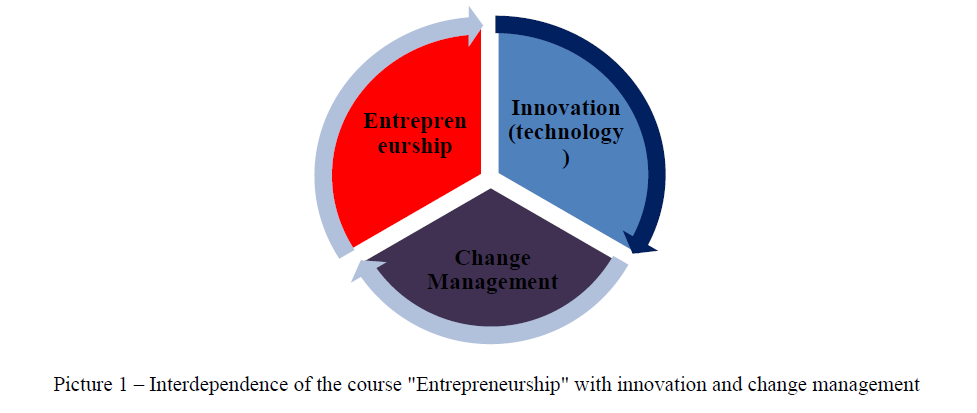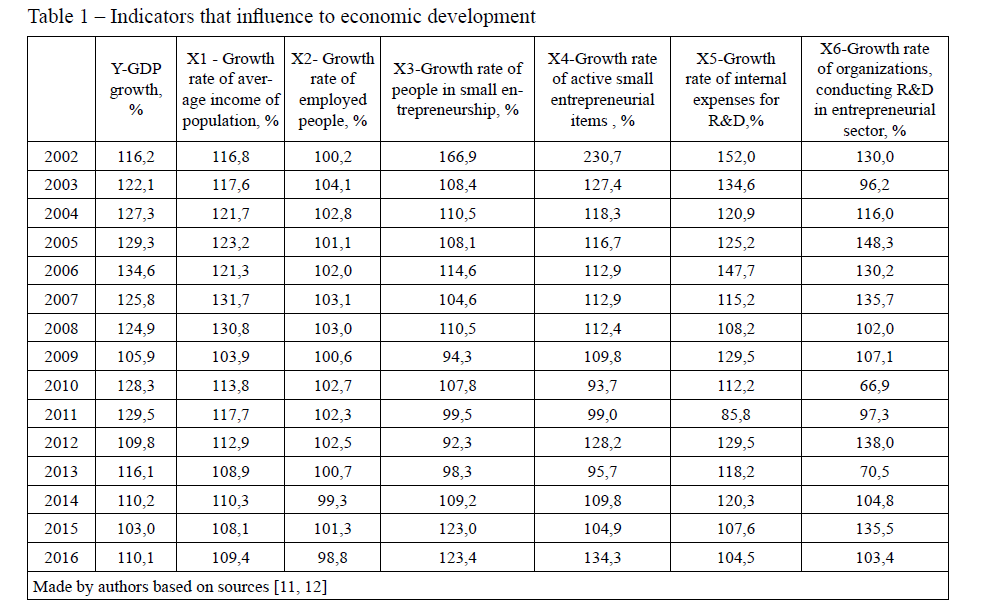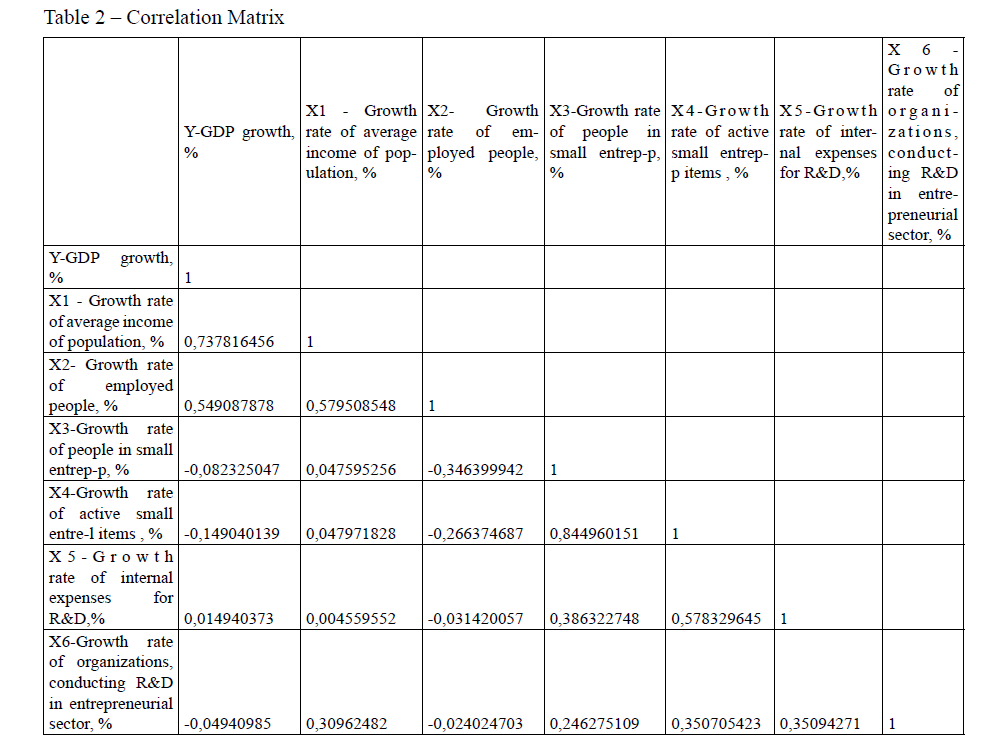Purpose – The aim of this paper is to identify a relation of economic growth with teaching of the course "Entrepreneurship" in university.
Methodology – analysis of current situation, also correlation model and regression analysis are used as a methodology of this paper.
Originality/value – The value of the research is that there is a real connection between economic growth and teaching of entrepreneurship by universities, as well as between personal trait of students and their entrepreneurial mindset.
Finding – Results of the research are based on multiplicative effect of considering combination of issues: human nature of learners, necessity of development of different syllabus depending on target audience, powerful impact of change management and innovation in teaching the course "Entrepreneurship".
Introduction
As it is aimed in this paper to define the relation between economic growth and teaching of the business courses, particularly "Entrepreneurship". By this, we mean how teaching in university impact on entrepreneurs’ mindset in order to behave actively and contribute economic development of the country.
According to the research, entrepreneurial activity is core for the economic growth of country. It is obvious, that outcome of entrepreneurial activity has a variety of effects, such as, people employed by themselves, taking responsibility for their future, contribute to the entire economic development of the country, increase of the income sources for state budget, freedom for creation and so on. Thus, by providing literature review, we noticed relevant links between education, venture creation and entrepreneurial activity [1]. Hence, this relation has impact on sustainable economic development of the country.
Analysis, thought and ideas
The search of connection between economic development and teaching in university of the course "Entrepreneurship" led us towards to the variety of issues. Due to consequence of searching connection between economic development and teaching of the course "Entrepreneurship" we can highlight several links.
First, this course "Entrepreneurship" closely tied with two elements such as innovation and change management. Their interrelation is inevitable.
Second, interesting fact is that government is ready to finance innovation in education, however, the "ground" (education) which going to be "watered" (financed, supported) is not ready yet. Therefore, we try to describe this connection in order to contribute to grasp the relation of economic development and teaching the course.
Third, during conducting research we came up with an idea that in order to transfer the knowledge to students the course ‘Entrepreneurship’ it requires some level of students’ readiness. That is their entrepreneurial mindset and intention of students’ that depend on students’ human nature. Therefore, the way of teaching "Entrepreneurship" will vary due to target audience.
Here, we attempt identify how to teach, what to teach.
How to teach implies who will be target audience. By this, we mean university students, or other knowledge-interested people who intended either to become an entrepreneur or to become an intrapreneur. Hence, to know target audience is important, because of entrepreneurial intention of participants. By saying so, we rely on exact research conducted by scientists of Tallinn University of Technology, and Tallinn School of Economics and Business Administration [2], Taiwan National Penghu University of Science and Technology [3]. According to their research, the result of teaching process and students’ outcome are high, however, it does not mean that entrepreneurial intention of students improved.
What to teach means the course content, which in turn replies ‘Entrepreneurship: about, for and in’ [4].
Fourth, university teaching way still focus on academic track, whereas private and other consultation centers concentrate to transfer to learners mostly applicable skills. Therefore, this paper based on these mentioned facts as a links in order to uncover the essence of main idea – relation between economic development and teaching of the course ‘Entrepreneurship’.

Picture 1 – Interdependence of the course "Entrepreneurship" with innovation and change management
Teaching of the course "Entrepreneurship" inevitably linked with innovation. It means the course content should consist of innovation elements as a driving force of economy. For example, it might occur in case of introducing new approaches for management, lunching new product or new details in service the ways of producing, selling, delivering of the product will be changed. Thus, these alterations require adapting and adopting these changes. It supposes entrepreneurship should take into consideration how to manage these changes.
The role of government is vital in achieving economic growth via implementing innovation. This is an interesting field for research and various public as well as private organizations are interested in it. The necessity of introducing innovation to the economy is undoubtedly. Today, governments of developing countries recognize this necessity and have already started to "water" (finance) the innovation, which is illustrated in next picture.

Picture 2 – "Gardening innovation and Education"
Regarding Kazakhstani economy, there are plenty of programs and special organizational vehicles, aimed on "watering" the innovation and entrepreneurship.
Two more functions of the "gardening" innovation, namely "removing weeds" (preparation of law and regulations) and "nurturing soil" (enhancing research and database) [5], can be developed and implemented simultaneously.
However, the fourth function, "preparation of the ground" (that is education), is less developed and stays behind. By providing literature review, we found several models where directly linked between education and innovation. Therefore, we claim that education as the "ground" of three other functions is a vital to further development of innovations, entrepreneurship and sustainable economic growth. Currently, as we notice, education does not properly operate as a "ground" yet in our country. That is the point in order to research and figure out what should be taught. If education removes the gap and even outrun, it will facilitate other three functions ("watering", "removing weeds" and "nurturing soil") and improve efficiency of the overall process of "gardening" innovation and education significantly.
The good illustration of inefficient "watering" is case of National Management Holding "Baiterek" [6], which really lacks good ideas and projects for financing, while possessing on the huge money "basket".
In order to contribute for development of economy from academic side, what we can do is to prepare the appropriate content of the course "Entrepreneurship". Attempting to cover the "gap" between real economic situation and teaching the course "Entrepreneurship" in university [7].
Now let’s explain out vision regarding "appropriate content" of the course which satisfy market demand, that can provide "necessary and applicable" knowledge to students, latters will have high employability, that "content" which can be served as a bridge between market (employer) and academic environment.
To identify such "content" requires detailing it. Before considering each "detail", we would like to provide a real experience of developing new syllabus.
One year ago we developed a new syllabus on course "Entrepreneurship" [8], it consists of three part, such as:
- Introduction to Entrepreneurship (topics are Entrepreneurial myth, Entrepreneurial models and Unsuccessful business stories);
- Business idea generation (idea generation, market segmentation, how to develop a product, how to look for investment and how to develop business plan);
- Legal aspects of entrepreneurship (which form of business to choose, how to run a business).
All mentioned topics are nice. However, if we ask how they can improve entrepreneurial intention of students, obviously answer will not be ready. Therefore, trying to answer to question "How to teach Entrepreneurship" we came up with an idea that we should divide the content of the course according to purpose how, for whom we are going to teach. Thus, if we are going to teach just to give an information about entrepreneurship than it will be "About Entrepreneurship", and the topics will cover business history, history of outstanding entrepreneurs, "heroes", what are production factors, how they influence, what student should know as a future entrepreneur, what makes them to fail all issues around "about", that is academic
if we are going to teach "For entrepreneurship", it implies what can be taught through university course taking into account personal traits students, that means through identifying natural traits of them. How we can identify is next question. Via using questionnaire, applying business games or others. It depends on teachers’ Strategy. But this work should be provided with first year students (first year of study) (we will share with one research example later in this example). So, what is personal trait that teacher should rely on developing syllabus.
In every society, there are four main social classes according to type of their personal traits, interests and professional occupation:
- scholars and teachers;
- rulers, warriors and administrators;
- merchants;
- laborers and service providers.
Table 1 – Indicators that influence to economic development

In order to educate successful entrepreneurs, sustainable in the long run, educators need to create or find some solid foundation for it. In case we clearly understand, who we are, and what is the mission of our life, it allows us to find the right center in life, based on solid principles, which is most important in changing environment [9]. The four results of discovering the right center are security, guidance, wisdom and power. That’s why our goal is not "producing" more and more entrepreneurs and deliver them to the economy. Our goal should be helping students to understand their mission first and become more independent in their life. And, after that, if a particular student realizes that his mission appears to be an entrepreneur, businessman, then our help will be arming him with all needed values, knowledge, skills and habits. In this case, we will provide qualitative entrepreneur to the economy in the long run, who will not change his mind.
- if we are going to teach "Entrepreneurship for", this is an approach in order to write a business plan, participating in workshops, consultancy projects [10].
- in case of aiming to teach "Entrepreneurship in", this supposes to develop a new product or service, startups or small and medium entrepreneurship internship.
By conducting this research, we recognized that it is not easy find and uncover connections between economic development and teaching entrepreneurship. However, we analyzed economic indicators. Now we can formulate certain statement about this relation.
Thinking logically, all these data are intertwined with each other. These relation between indicators demonstrates that this is a link between number of people who do their own business and state expenses for R&D and GRP growth.
Table 2 – Correlation Matrix

As it is shown in correlation matrix, that namely two indicators are correlated with economic growth: X1
Growth rate of average income of population and X2 – Growth rate of employed Through forecasting the growth of employed people in small entrepreneurship for 4%, we can predict increasing of economic growth for 10%. Which is very positive. This is forecasting for 2017.
Now we can rely on this calculation and conclude the idea that if number of people increase in small entrepreneurship, that directly impact on economic development positively.
Conclusion
In this research, we tried to define relation economic development of the country and the role of teaching of particular course "Entrepreneurship" in university. Still we have no completely finalized ready answer for various questions related with teaching process. For example, what is the aim of teaching Entrepreneurship? This is not quite simple question. Through this paper, we attempted to reply for it from different angles. So, we do know that we cannot burn desire of students to create business until the mind changes. Therefore, as it is told, depending on natural ability of each student, we should give them what they want and need. Next, mindset may change if they are involved to solve broad range of social and economic issues. This is definitely might be as one way to develop entrepreneurial intention.
Thus, taking into account this research results we came up with an idea that teacher should elaborate various curricula (syllabus) for the content "Entrepreneurship". This may help to understand and apply two different things
- four aspects (about, for entrepreneurship, entrepreneurship for and in). These aspects facilitate to build the methodology of the course and serve as didactics.
- Relation between three components – entrepreneurship, innovation, change management – in order to grasp the importance of properly teaching for entire economic development of the
Therefore, the syllabus of the course "Entrepreneurship" can incorporate two different aspects conceptual (theoretical) and practical.
As our research indicates that the course content will vary depending on target audience. It is highlighted, about identifying students’ ability in order to know what to teach them. It means we should define the instrument for identification of students’ ability, such as questionnaire, simulation games, group work – the aim by using these instruments is to uncover their ability, intention and their nature. There is already conducted research by Krzysztof Rybinski and his colleague Hans Holzhacker looking for answer how to help students to become successful. By providing questionnaire authors of the research work "Can we help student become successful? ", [13] they defined the root of the many problems for students, and figured out how to motivate them. Why this research attracted our attention, because of defining students’ personality and nature.
There is a well-known example of outstanding business leader Brain Tracy – when university students were asked "what they are aiming to achieve in their life?", only ten percent of them knew what they wanted being as a student [14]. Ten years later, these graduated were observed again. The result was amazing; those students have already achieved what they aimed. That makes clear to answer for article’s questions. Students ability, natural trait must be identified by their majoring in certain field [15]. In this case, teachers’ effort in knowledge transferring will be more successful.
References
- Mário Raposo, Arminda do Paço Entrepreneurship education: Relationship between education and entrepreneurial activity [Electronic source] // Psicothema. – 2011. – № 23. – URL: http://www.psicothema. com/ (accessed: 05.12.2016)
- Merle Kuttim, Marianne Kallaste, Urve Venesaar, Aino Entrepreneurship education at university level and students’ entrepreneurial intentions // Procedia – Social and Behavioral Sciences. – 2014. – № 110. – pp. 658-668.
- Su-Chang Chen, Hsi-Chi Hsiao, et. all Can the entrepreneurship course improve the entrepreneurial intentions of students? – NY: Springer Science+Business Media,
- Per Blenker, Steffen Korsgaard, Helle Neergaard, Claus Thrane The questions we care about: paradigms and progression in entrepreneurship education // Industry & Higher Education. – 2011. – № 25 (6).
- Innovation A Guide for Developing Countries. The International Bank for Reconstruction and Development // The World Bank. – 2010. – pp. 9-12.
- National Managing Holding "Baiterek" [Electronic source]. – URL: https://www.baiterek.gov.kz/ru/ activities/state-programs/msb-program-support/ (accessed: 06.01.2017)
- Nathalie Duval-Couetil. Assessing the Impact of Entrepreneurship Education Programs: Challenges and Approaches // Journal of Small Business Management. – 2013. – № 51 (3). – pp. 394-409.
- Syllabus of Narxoz
- Stephen Covey The 7 habits of highly effective people [Electronic source]. – URL: https://www.depts. ttu.edu/upwardbound/books/the-7-habits-ofhighly-effective-people.pdf (accessed: 11.2016)
- How to write a business plan [Electronic source]. – McKinsey & Company, Inc. – p. 4. – URL: http://14k.inc.hse.ru/files/McKINSEY_GUIDE_to_business_plan.pdf (accessed: 01.2017)
- Official web-site of the Committee on Statistics of The Ministry of National Economy of the Republic of Kazakhstan [Electronic source]. – URL: stat.gov.kz (accessed: 12.2016)
- Министерство национальной экономики Республики Казахстан. Комитет по статистике. Социально-экономическое развитие Республики Казахстан. Январь-февраль 2017. Краткий статистический бюллетень. –
- Rybinski K., Holzhacker H. Can we help student become successful? Material from research seminar in Narxoz University. – October
- Fayolle A., Gailly B. The Impact of Entrepreneurship Education on Entrepreneurial Attitudes and Intention: Hysteresis and Persistence // Journal of Small Business Management. – 2013.
- Souitaris , Zerbinati S., Al-Laham A. Do entrepreneurship programmes raise entrepreneurial intention of science and engineering students? The effect of learning, inspiration and resources // Journal of Business Venturing. – 2007. – № 22.